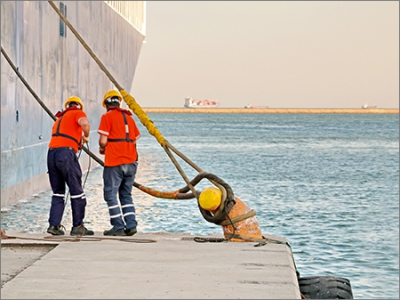Challenges faced and Lessons to be learned
Confidential Hazardous Incident Reporting Programme (CHIRP) has received a report related topoor communications and misuse of the mooring equipment.
Report text:
“The vessel was moored alongside and had completed cargo operations. I was posted as Officer in Charge of the forward mooring station. We were secured alongside starboard side to the berth with three headlines (and stern lines) and two springs in good weather, slight to moderate wind on the port beam and a slight sea. The Master, on the bridge in command, instructed the forward station to ‘single up to 1 and 2’. This was carried out without any problems.
“Subsequently, we were ordered to ‘single up to 1 and 1’. I asked the crew to let go the remaining headline, which was carried out safely. The Master then instructed us to let go the remaining spring. However, a riding turn had developed on the winch which prevented us from providing sufficient slack for the linesmen ashore to slip the spring from the bollard. I informed the Master of the situation. He simply replied with ‘Let go the spring’. At this time, I could hear the bow thruster begin operating and the bow began slipping the berth, with the spring still ashore.
“I am not aware of what was happening on the bridge at the time ie. was the Master answering a telephone call or in conversation with the docking pilot at that moment. It may simply have been a momentary lapse in concentration on the part of the Master, which may lead us to question the quality of bridge team management activity on this vessel. At the time in question, the Master was accompanied by the Chief Officer, a Docking Pilot and a River Pilot suggesting that the attention of the entire bridge team was elsewhere. Communication between the mooring stations and bridge was by VHF, and there was no interference or cross channel interruptions at any point during the operation. Quality of reception was loud and clear for all parties.
CHIRP Comment
This report was forwarded to the vessels operator; an edited extract of the response follows:
We take such incidents very seriously and I have asked all of our vessels and Masters to investigate as to whether this incident could have occurred onboard their vessel and what steps must be taken to avoid such an incident.
There are several factors which give me cause for concern. The poor communications, the misuse of the mooring equipment – all vessels are fitted with split drum winches to avoid any riding turns and damage to the ropes – the failure of the Master or Officer on the bridge to visually check that the ropes were clear before using the bow thruster and the failure of the Officer concerned to report this incident as a near miss under our Safety Management System.
If the Officer had a communication problem with the Master then he should have contacted myself as DPA to discuss the incident.
The Board endorses this view and emphasises the importance of near-miss reporting directly to the DPA if it is not possible to use the normal process.
This response was followed up with a message to the fleet:
Please read and discuss the report and see if this incident could have happened on your vessel and what steps you have to take to prevent such an incident happening. The main focus of the investigation would seem to be communications between the bridge and the focsle where the informant claims that he was unable to contact the Master or Chief Officer.
My own thoughts on the matter are two fold. Firstly, every Master that I have ever observed has always stayed on the bridge wing watching the quay and the lines and making sure that his orders are carried out. Secondly, the normal practise on most vessels is for the last spring and headline to come directly from the split drum reels and therefore there should not be the opportunity to have riding turns on the winch. It would seem there is conflicting evidence in this report.
A third point which again cannot be proven is why if the Master and Chief Officer were both on the bridge and both have VHF radios then even if the Master was distracted by talking to the pilot the Chief Officer would have been able to respond to the call from the Officer on the focsle.
If this report is true and the incident did occur as described then it also shows poor seamanship in that the bow thruster was used prior to the master ascertaining that the ropes forward were all clear.
Source:CHIRP






























































